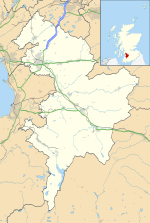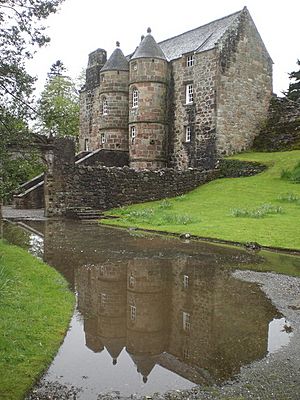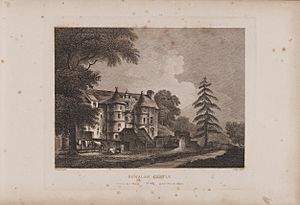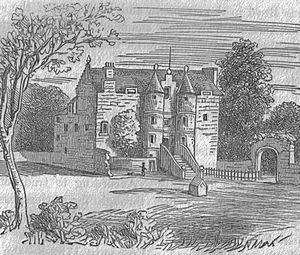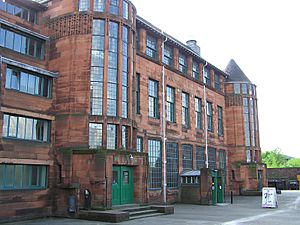Rowallan Castle facts for kids
Quick facts for kids Rowallan Castle |
|
|---|---|
| Kilmaurs, East Ayrshire, Scotland UK |
|
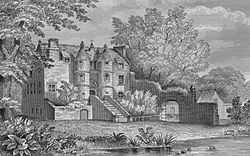
Rowallan Castle in 1876
|
|
| Coordinates | 55°39′00″N 4°29′19″W / 55.65°N 4.488639°W |
| Site information | |
| Owner | Niall Campbell and family |
| Controlled by | Campbell family |
| Open to the public |
Occasional open days |
| Condition | Fully intact |
| Site history | |
| Built | 16th century |
| In use | Until 20th century |
| Materials | stone |
Rowallan Castle is an old castle found in Scotland. Its name in Scottish Gaelic is Caisteal an Rubha Àlainn, which means 'beautiful headland'. The castle sits by the Carmel Water. This river might have been closer to the castle's hill a long time ago, which explains its old name, Craig of Rowallan. Elizabeth Mure, who later married King Robert II, might have been born here.
Contents
The Story of Rowallan Castle
Who Owned Rowallan Castle?
Over the years, many important families have owned Rowallan Castle. These include the Muir family from the Middle Ages, the Boyle family (who were Earls of Glasgow), the Campbell family (who were Earls of Loudoun), and the Corbett family (who were Barons Rowallan).
In 1989, the castle went back to the Campbell family. It is said that the very first piece of Lute music was written at Rowallan. It is also believed that King James I visited the castle on his way from Edinburgh to England.
How Rowallan Castle Began
The first castle on this spot probably dates back to the 13th century. Rowallan is thought to be the birthplace of Elizabeth Mure. She was the first wife of Robert, who later became Robert II of Scotland, a king of Scotland.
In 1513, John Mure of Rowallan died in the Battle of Flodden. Around this time, the Rowallan Estate became the size and shape it is today. By about 1690, the estate was home to the Campbells of Loudoun. They owned it for many years, into the 19th century.
Building and Special Features
The castle is built on a small hill. It used to be surrounded by a small lake or a marshy area, fed by the Carmel Burn. The front part of the castle facing south was built around 1562. This was done by John Mure of Rowallan and his wife, Marion Cuninghame. You can see their names and the year 1562 carved into a stone at the top of the wall.
The Mure family's symbol, a "Moore's head," is carved near their family shield. This is a play on their name, Mure. The Royal Arms of Scotland are carved above the main entrance. There are also shields of the Cumin family, from whom the Mures say they are descended. Above an ornate gate, there is a stone with the date 1616.
Over the porch doorway, there is a rare carving in Hebrew. It says, "The Lord is the portion of mine inheritance and of my cup," from Psalms XVI, Verse 5. A special stone for helping people get onto horses, called a loupin-on-stane, used to stand at the front of the castle. Rowallan also had a good well with clean water. There is also a "King William's well" nearby.
One room in the castle was called "Lord Loudoun's sleeping apartment." Many visitors wrote their names and poems on the walls of the rooms. Sir John and Sir William Muir enjoyed building different parts of Rowallan. They also spent a lot of time planting trees and gardens around the castle.
Part of the castle was known as the "Woman's House." This shows that, in the past, men and women from wealthy families often had separate living areas. The ladies of the house would do sewing and other work in these rooms.
In the 19th century, Edith Rawdon-Hastings, 10th Countess of Loudoun, loved Rowallan very much. She spent a lot of money fixing the castle. Because of her efforts, the building is still standing today.
The "Row Allan, Row!" Story
There's a fun story about how the castle got its name. It's about a man named Allan from Stewarton. One day, he was rowing a Scottish chief off the coast of Ayrshire. The weather turned bad, and the chief got scared. He told Allan, "Row, Allan, row! Get me to safety, and you'll get rich lands, silver to build a castle, and rivers full of fish!" Allan managed to save the chief and got his reward. He named his new estate "Rowallan" after his adventure.
However, this is a "folk etymology," which means it's a popular story about a name's origin that isn't actually true. The real meaning of Rowallan comes from the Scottish Gaelic words 'Rubha Àlainn', meaning 'beautiful headland'.
During Covenanting Times
Sir William Mure wrote a history of his family. He was a strong supporter of the Covenanters, a group who wanted to protect their religion. Even so, he was against the execution of King Charles I.
Meetings of Covenanters were often held inside the castle. Because of this, Sir William was sometimes suspected by the government and even put in prison. Part of the old castle is still called the "Auld Kirk" (Old Church) to remember these times. Sir William helped the Covenanters and tried to protect his tenants from soldiers. He was friends with Rev. William Guthrie, who preached in the castle's "auld kirk" many times.
In the 1640s, a soldier named Alasdair Mac Colla came to Ayrshire to stop support for the Covenanters. He caused damage and demanded money. Sir William Mure had to pay a large sum to stop further damage at Rowallan.
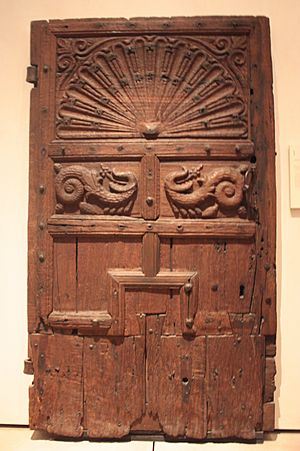
The Tree Fox of Rowallan
A story tells of a fox that lived in a tree in the old garden at Rowallan. This fox would watch everything from its perch. It was smart enough to leave the chickens alone! One day, the fox was being chased by hunters and their dogs. It ran and hid in its tree, surprising everyone. The housekeeper tried to get the fox out, but it escaped and was back in its tree the next day!
The Marriage Tree
Near the castle, there was a tall "marriage tree." It stood over a deep crack in the ground where the Carmel river flows. This spot was known as "Janet's Kirn." Under this tree, Dame Jean Mure of Rowallan was married to William Fairlie. This was part of a planned elopement, where the couple ran away to get married.
Rowallan and a Visit from Auld Nick
The main stair leading to the castle's door has a crack. People say this crack was made by the Devil himself!
The Box Hedge
A very large box hedge was planted in the Rowallan castle garden, possibly around 1687. It was still a beautiful sight in 1817, but by 1847, it had started to decay.
The Edwardian Castle
A second, more modern castle was built on the Rowallan grounds. It was updated and the gardens were redesigned between 1902 and 1906. This work was done by a famous architect named Sir Robert Lorimer. The original 16th and 17th-century Rowallan Castle was kept.
This old castle was looked after by Historic Scotland for a while. In 2015, its status changed. It is now allowed to be used as guest accommodation, but there are still rules to make sure the historic building is protected.
Charles Rennie Mackintosh's Inspiration
The famous architect Charles Rennie Mackintosh is said to have used Rowallan Castle and Falkland Palace as inspiration for his design of Scotland Street School in Glasgow.
Dalmusternock House
Dalmusternock House was built in 1615 by William Mure. It was meant to be a home for his wife, Anna Dundas, after they got married.
Images for kids
-
16th-century oak door from Rowallan Castle, Royal Scottish Museum


